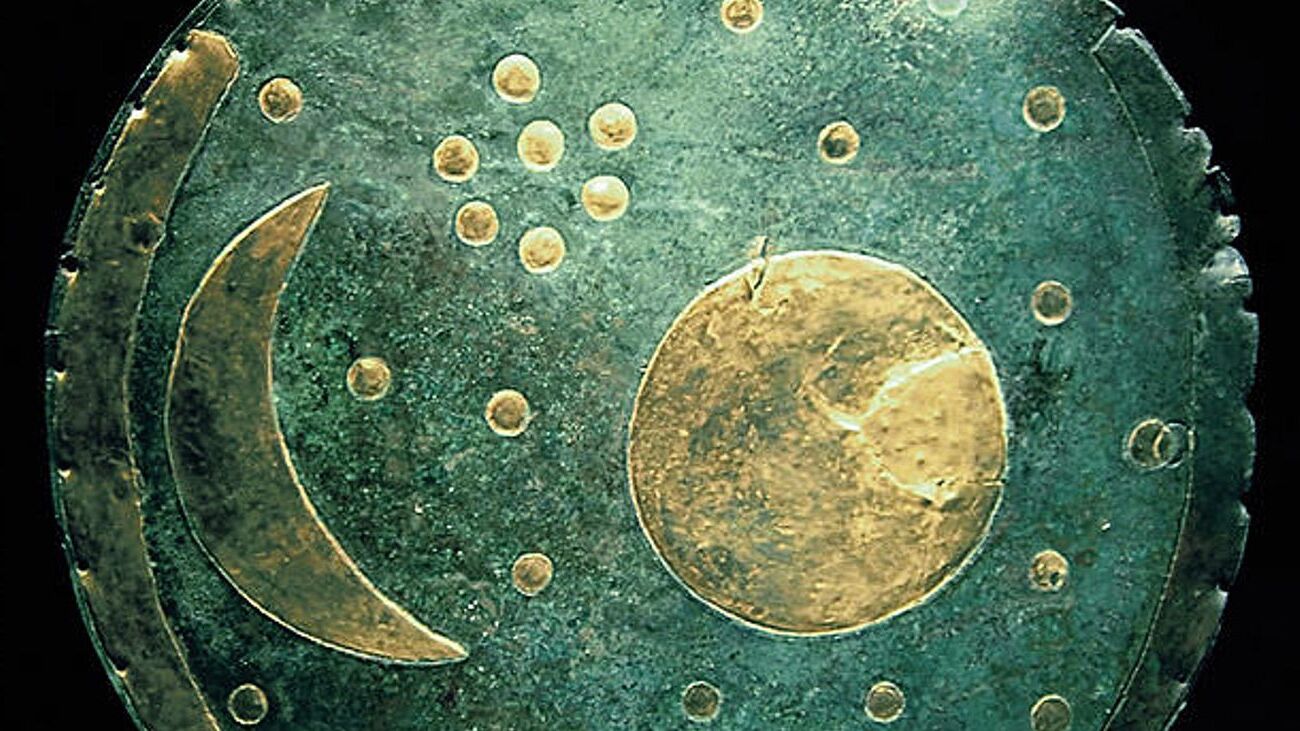
What is the Nebra Sky Disc? Imagine stumbling upon an ancient artifact that rewrites history. The Nebra Sky Disc, discovered in 1999 near Nebra, Germany, is exactly that. Dated to around 1600 BC, this bronze disc is the oldest known realistic depiction of the cosmos. Measuring about 30 cm in diameter and weighing 2.2 kg, it features gold symbols representing the sun, moon, and stars, including the Pleiades. This artifact offers a glimpse into the astronomical knowledge of the Early Bronze Age Únětice culture. Its intricate design and precise astronomical markers reveal a sophisticated understanding of celestial movements.
Key Takeaways:
- The Nebra Sky Disc, a Bronze Age artifact, was discovered under chaotic circumstances and holds immense historical and cultural significance, shedding light on ancient European societies' astronomical knowledge and practices.
- Valued at $11.2 million and recognized by UNESCO, the Nebra Sky Disc's precise astronomical markings and cultural symbolism reflect the advanced knowledge and rich traditions of its creators, offering insights into ancient European beliefs and values.
Discovery and Initial Chaos
The Nebra Sky Disc, a fascinating artifact, was unearthed under rather chaotic circumstances. Let's delve into its discovery and the initial turmoil that followed.
-
Discovery: In 1999, two treasure hunters, Henry Westphal and Mario Renner, stumbled upon the Nebra Sky Disc in a forest near Nebra, Saxony-Anhalt, Germany, using metal detectors.
-
Initial Find: The discovery was far from smooth. The treasure hunters damaged the disc and destroyed parts of the site. They sold the items to a dealer in Cologne, who then sold them to various collectors.
-
Archaeological Recovery: By 2002, state archaeologist Harald Meller tracked down the items and the original finders, leading to the excavation of the site and recovery of the disc. It was then taken to the State Museum of Prehistory in Halle.
Significance and Age
The Nebra Sky Disc is not just any artifact; it holds immense historical and cultural significance. Let's explore its importance and age.
-
Significance: This disc is considered one of the most important archaeological finds of the past century, shedding light on the astronomical knowledge and cultural practices of ancient European societies.
-
Age: Dated to around 1600 BC, the disc belongs to the Early Bronze Age, specifically linked to the Únětice culture.
Material and Design
The Nebra Sky Disc's material and intricate design are a testament to the advanced craftsmanship of its creators.
-
Material: Made from bronze with a blue-green patina, the disc features inlaid gold symbols. The blue-green color likely resulted from a chemical reaction involving rotten eggs.
-
Size: Measuring approximately 30 cm (12 inches) in diameter and weighing about 2.2 kg (4.9 pounds), the disc is a substantial artifact.
-
Astronomical Symbols: The gold symbols on the disc represent a crescent moon, the sun (or full moon), and stars, including the Pleiades. These symbols were likely used for astronomical calculations to determine planting and harvest times.
Astronomical Use and Observation Site
The Nebra Sky Disc's primary function was astronomical, and its creation site played a crucial role.
-
Astronomical Use: Researchers believe the disc served as an astronomical clock to synchronize the lunar and solar years, crucial for agricultural societies.
-
Observation Site: Created by observing the heavens from Mittelberg hill near Nebra, the disc's raw materials came from as far as Cornwall, England, while the knowledge required was local.
Bronze Age Context and Development Phases
The disc's context within the Bronze Age and its development phases reveal much about its creators' knowledge and intentions.
-
Bronze Age Context: Linked to the Early Bronze Age Únětice culture, known for sophisticated metalworking and astronomical knowledge.
-
Phases of Development: The disc underwent five development phases. Initially, it depicted the night sky with 32 gold stars, including the Pleiades, a gold orb representing the sun or full moon, and a crescent moon. Later phases added golden arcs to mark the solstices and a stylized ship at the bottom.
Solstice Markers and Solar Boat Symbolism
The disc's solstice markers and solar boat symbolism highlight its creators' precise astronomical knowledge and cultural beliefs.
-
Solstice Markers: The golden arcs on the sides mark the angle between the summer and winter solstices, showing the horizons as seen from Mittelberg on these solstices.
-
Solar Boat Symbolism: The stylized ship at the bottom represents the sun’s journey across the sky, added in a later phase of the disc’s development.
Burial and Controversy
The Nebra Sky Disc's burial and the controversy surrounding its authenticity add layers to its intriguing history.
-
Burial: The disc was ritually buried with two swords, two hatchets, a bronze chisel, and fragments of spiral bracelets, suggesting it was considered an offering to the gods.
-
Controversy: In 2004, German archaeologist Professor Peter Schauer claimed the disc was a modern fake. However, subsequent examinations by German scholars in 2006 confirmed its authenticity and function as a complex astronomical-astrological clock.
Scientific Dating and Exhibition History
Scientific dating and the disc's exhibition history provide further insights into its significance and public reception.
-
Scientific Dating: Precise dating was achieved by analyzing the Bronze Age weapons buried with the disc. Tests on the wood and gold artifacts narrowed the age to around 1600 BC.
-
Exhibition History: The disc has been part of several exhibitions, including "Der geschmiedete Himmel" (The Forged Sky), showcasing 1,600 Bronze Age artifacts, including the Trundholm sun chariot.
UNESCO Recognition and Value
The Nebra Sky Disc's recognition by UNESCO and its estimated value underscore its global importance.
-
UNESCO Recognition: In June 2013, the disc was included in the UNESCO Memory of the World Register, recognizing its historical and cultural significance.
-
Value: Valued at approximately $11.2 million, some researchers believe it may have been part of a pair, with the other disc still missing.
Astronomical Precision and Cultural Significance
The disc's astronomical precision and cultural significance highlight the advanced knowledge and rich traditions of its creators.
-
Astronomical Precision: The disc's symbols and markings demonstrate a high level of precision, indicating a deep understanding of celestial movements, evident in the accurate depiction of solstices and other phenomena.
-
Cultural Significance: Beyond its astronomical use, the disc reflects the spiritual and artistic practices of ancient European societies, providing insights into their beliefs and values.
Exhibition at British Museum and Archaeological Context
Recent exhibitions and the archaeological context of the disc's creation offer further understanding of its significance.
-
Exhibition at British Museum: In 2022, the disc was loaned to the British Museum for an exhibition on Stonehenge, making it accessible to a broader audience.
-
Archaeological Context: The discovery has shed light on the archaeological context of its creation. The site, Mittelberg hill, is an Iron Age ring wall enclosure aligning with the solstices, emphasizing its astronomical significance.
Ongoing Research
Despite extensive study, the Nebra Sky Disc continues to intrigue scholars, with ongoing research exploring its mysteries.
- Ongoing Research: The disc remains a subject of ongoing research. Its precise purpose and extent of use continue to be debated, highlighting the complexity and richness of ancient cultures.
The Nebra Sky Disc's Lasting Impact
The Nebra Sky Disc stands as a testament to the advanced astronomical knowledge of ancient European societies. Discovered in 1999, this 3,600-year-old artifact offers a unique glimpse into the cosmic understanding of the Bronze Age. Its intricate design, featuring a crescent moon, sun, and stars, highlights the sophisticated astronomical calculations used for agricultural planning. The disc's precise solstice markers and solar boat symbolism further emphasize its cultural and spiritual significance. Despite initial controversies, extensive research has confirmed its authenticity, solidifying its place in history. Now housed at the State Museum of Prehistory in Halle, the Nebra Sky Disc continues to captivate scholars and the public alike. Its inclusion in the UNESCO Memory of the World Register underscores its global importance. As ongoing research unfolds, the Nebra Sky Disc remains a fascinating window into the past, bridging ancient wisdom with modern curiosity.
Frequently Asked Questions
Was this page helpful?
Our commitment to delivering trustworthy and engaging content is at the heart of what we do. Each fact on our site is contributed by real users like you, bringing a wealth of diverse insights and information. To ensure the highest standards of accuracy and reliability, our dedicated editors meticulously review each submission. This process guarantees that the facts we share are not only fascinating but also credible. Trust in our commitment to quality and authenticity as you explore and learn with us.


